Salcido A. (ed.) Cellular Automata - Simplicity Behind Complexity
Подождите немного. Документ загружается.


Knospe, W., Santen, L., Schadschneider, A., Schreckenberg, M. (2000). Towards a realistic
microscopic description of highway traffic. Journal of Physics A, 33:L477-L485.
Kerner, B. S. (2004). Three-phase traffic theory and highway capacity. Physica A, 333:379-440.
Kerner, B. S., Klenov, S. L. (2002). A microscopic model for phase transitions in traffic flow.
Journal of Physics A, 35:L31-L43.
Kerner, B. S., Klenov, S. L., and Wolf, D. E. (2002). Cellular automata approach to three-phase
traffic theory. Journal of Physics A, 35:9971-10013.
Laval, J. A., and Leclercq. L. (2010). A mechanism to describe the formation and propagation
of stop-and-go waves in congested freeway traffic. Philosophical Transactions Of The
Royal Society A-Mathematical Physical And Engineering Sciences, 368:4519-4541.
Lee, K., Hui, P. M., Wang, B. H., and Johnson, N. F. (2001). Effects of announcing global
information in a two-route traffic flow model. Journal of the Physical Society of Japan,
70:3507-3510.
Li, X. B., Wu, Q. S., Jiang, R. (2001). Cellular automaton model considering the velocity effect
of a car on the successive car. Physical Review E, 64:066128.
Mahmassani, H. S. and Jayakrishnan, R. (1991). System performance and user response under
real-time information in a congested traffic corridor. Transportation Research Part A,
25:293-307.
Mao, D., Wang, B. H., Wang, L., Hui, R. M. (2003). Traffic flow CA model in which only the cars
following the trail of the ahead car can be delayed. International Journal of Nonlinear
Science and Numerical Simulation, 4:239-250.
Nagatani, T. (2002). The physics of traffic jams. Reports on Progress in Physics, 65:1331-1386.
Nagel, K. and Schreckenberg, M. (1992). A cellular automaton model for freeway traffic. J.
Phys. I, 2:2221-2229.
Paveri-Fontana, S.L. (1975). Boltzmann-like treatments for traffic flow - critical review of basic
model and an alternative proposal for dilute traffic analysis. Transportation Research,
9:225-235.
Prigogine, I. and Andrews, F. C. (1960). A Boltzmann-like approach for traffic flow. Operations
Research, 8:789-797.
Rothery, R. W. (1992). Gartner, N., Messner, C. J., and Rathi, A.J., editors, Traffic Flow Theory.
Transportation Research Board: Transportation Research Board Special Report, 165:
Chapter 4. Washington, D.C.
Wahle, J., Bazzan, A. L. C., Klügl, F., and Schreckenberg, M. (2000). Decision dynamics in a
traffic scenario. Physica A 287:669-681.
Wahle, J., Bazzan, A. L. C., Klügl, F., and Schreckenberg, M. (2002). The impact of real-time
information in a two-route scenario using agent-based simulation, Transportation
Research Part C, 10:399-417.
Wang, B. H., Mao, D., and Hui, P. M. (2002). The two-way decision traffic flow model:
Mean field theory. In: Proceedings of The Second International Symposium on Complexity
Science, Shanghai, August 6-7, pages 204-211.
Wang, B. H., Mao, D., Wang, L., Hui, P. M. (2003). Traffic and Granular Flow’01, Fukui,
M., Sugiyama, Y., Schreckenberg, M., and Wolf, D. E., editors, Spacing-Oriented
Analytical Approach to a Middle Traffic Flow CA Model Between FI-Type and
NS-Type, pages 51-64. Springer-Verlag Press.
Wang, B. H., Wang L., Hui, P. M., and Hu B. (2000a). The asymptotic steady states of
deterministic one-dimensional traffic flow models. Physica B, 279:237-239. 32
257
Application of Cellular Automaton Model to
Advanced Information Feedback in Intelligent Transportation Systems

Wang, B. H.,Wang L., Hui, P. M., and Hu B. (2000b). CA model for 1-D traffic flow with
gradual acceleration and stochastic delay: Analytical approach. International Journal
of Nonlinear Science and Numerical Simulation, 1:255-266.
Wang L., Wang, B. H., and Hu B. (2001). Cellular automaton traffic flow model between the
Fukui-Ishibashi and Nagel-Schreckenberg models. Physical Review E, 63:056117.
Wang, W. X., Wang, B. H., Zheng, W. C., Yin, C. Y., and Zhou, T. (2005). Advanced information
feedback in intelligent traffic systems. Physical Review E, 72:066702.
Yokoya, Y. (2004). Dynamics of traffic flow with real-time traffic information. Physical Review
E, 69:016121.
258
Cellular Automata - Simplicity Behind Complexity

Pawel Topa
AGH University of Science and Technology
Poland
1. Introduction
Most historical sources say that Cellular Automata were discovered by John von Neumann
and Stanislaw Ulam in the forties of the twentieth century. Von Neumann was investigating
the problem of self-reproducing systems in biology. His initial kinematic model appeared to be
too complicated and he followed the suggestion from Stanislaw Ulam, who at the same time
worked on problems of crystal growth. Von Neumann and Ulam defined an abstract universe
in the form of two-dimensional regular mesh with interacting entities Neumann (1966).
In the seventies mathematician John Conway published his set of rules called "Game of
Life". His work was popularized by Martin Gardner in the pages of Scientific American. The
rules of "Game of Life" implemented on computers showed an amazing world of living and
dying automata. Its dynamics appeared to be so surprisingly complex that it became area
of intensive studies. Vast amount of work concentrated on searching for initial conditions
that evolve into non-trivial behaviour of Cellular Automata. One of the most important
achievement was proving that "Game of Life" can simulate Universal Turing Machine i.e. can
act as an abstract model of any computer.
In the eighties Stephen Wolfram spent part of his scientific career on investigating properties
of one-dimensional Cellular Automata. His important achievement was definition of 256 rules
for one-dimensional Cellular Automata. He also introduced first classification scheme based
on long period observation. The crowning achievement of his works was a book "A New kind
of Science" Wolfram (2002). In this monumental work Wolfram outlines a new paradigm for
modelling complex phenomena with Cellular Automata approach.
Scientific research related to Cellular Automata were not only limited to abstract mathematical
“toy”. Toffoli, Margoulus and Fredkin postulated application of cellular automata for
modelling physical systems Chopard & Droz (1998); Toffoli & Margolus (1987). They noticed
that physical laws can be encoded in rules of interaction in temporally and spatially discrete
universe.
The milestone in Cellular Automata theory was the lattice gas model HPP developed by
Hardy et al. (1976). The model, which is in fact the Cellular Automata, consists of a simple
and fully discrete system of moving and colliding particles. Although, the idea of lattice
gas automata was invented independently, the Cellular Automata theory provided clear
conceptual framework. HPP model and his successor FHP Frisch et al. (1986) was successful
in modelling complex phenomena as flows in porous media, spreading of a liquid droplet and
wetting phenomena.
It is difficult now to figure out all the areas where the Cellular Automata paradigm is applied:
Network Systems Modelled by Complex
Cellular Automata Paradigm
12

• biological processes: tissue growth Wang et al. (2008), angiogenesis Markus et al. (1999),
cancer development Reis et al. (2009) etc.
• chemical processes Chopard & Droz (1998); Kier (2000); Kier et al. (1998),
• granular flow Baxter & Behringer (1991); Masselot & Chopard (1996),
• pedestrian dynamics and traffic flow Blue et al. (1997); Was (2005),
• geological processes D’Ambrosio et al. (2001).
“Cellular Automata Modelling of Physical Systems” by Chopard & Droz (1998) contains
very profound review of various applications of Cellular Automata approach for modelling
physical systems.
Cellular Automata in their classic meanings have rather limited application area. On the
other hand their simplicity in computer implementation is irresistible temptation. A lot of
extensions were introduced to their definition. The set of states was extended by introducing
floating point numbers instead of logical values. The neighbourhood notion was extended
by introducing new schema (von Neumann, Moore and Margoulus neighbourhoods) and
range bigger then one cell. The homogeneity of Cellular Automata were also broken. In
some applications synchronous updating were also replaced by other asynchronous schemas.
Mesh types other then rectangular were also applied in some models. Some extensions make
that model is so far from classic Cellular Automata definition that it could be classified as a
different modelling tool. The Cellular Potts model Graner & Glazier (1992) and Agent-Base
models Wooldridge (2009) can be treat as generalized Cellular Automata.
Cellular automata paradigm fits perfectly to paradigm of computation on digital computers.
When we use Cellular Automata approach we do not have to struggle with round-off
errors, truncation errors, numerical stability and lots of other problems that appear when we
implement methods of numerical analysis on computers. Rules of local interaction can be
easily and unambiguously defined by using programming languages constructions (if ... then
... , while ... do ...). Algorithms and data structures necessary to develop Cellular Automata
models are relatively simple and give great opportunity to efficient implementation.
Moreover, Cellular Automata are inherently parallel. Cellular Automata definition states that
cells have to be processed simultaneously. Computer implementation have to simulate this
by using additional temporary data structure. In the 80s and 90s of 20th century a lot of
work had been devoted to constructing hardware implementation of Cellular Automata.
The most famous were Cellular Automata Machines built by Tommaso Toffoli and Norman
Margoulus (CAM-6 i CAM-8) Margolus et al. (1986); Toffoli & Margolus (1987). There were
also successful attempts to implement CA on transputer machines Cannataro et al. (1995);
Somers & Rem (1989) however this architecture did not succeed an fallen into oblivion. Finally,
these interesting researches were abandoned in favour of flexibility of programming solutions.
Recent research in GPGPU computing methods shows that Cellular Automata can run very
effective on graphic processors Gobron et al. (2010).
In this chapter I present applications of Cellular Automata paradigm for modelling
dynamically evolving system with networks structure that function as transportation
pathways. The following section presents phenomena that was studied and modelled by the
author. Next I present the general idea of Graph of Cellular Automata that combine of Cellular
Automata and graphs. In further section I present two models that employed Graph Cellular
Automata:
• model of anastomosing river system,
• model of tumour induced angiogenesis.
260
Cellular Automata - Simplicity Behind Complexity
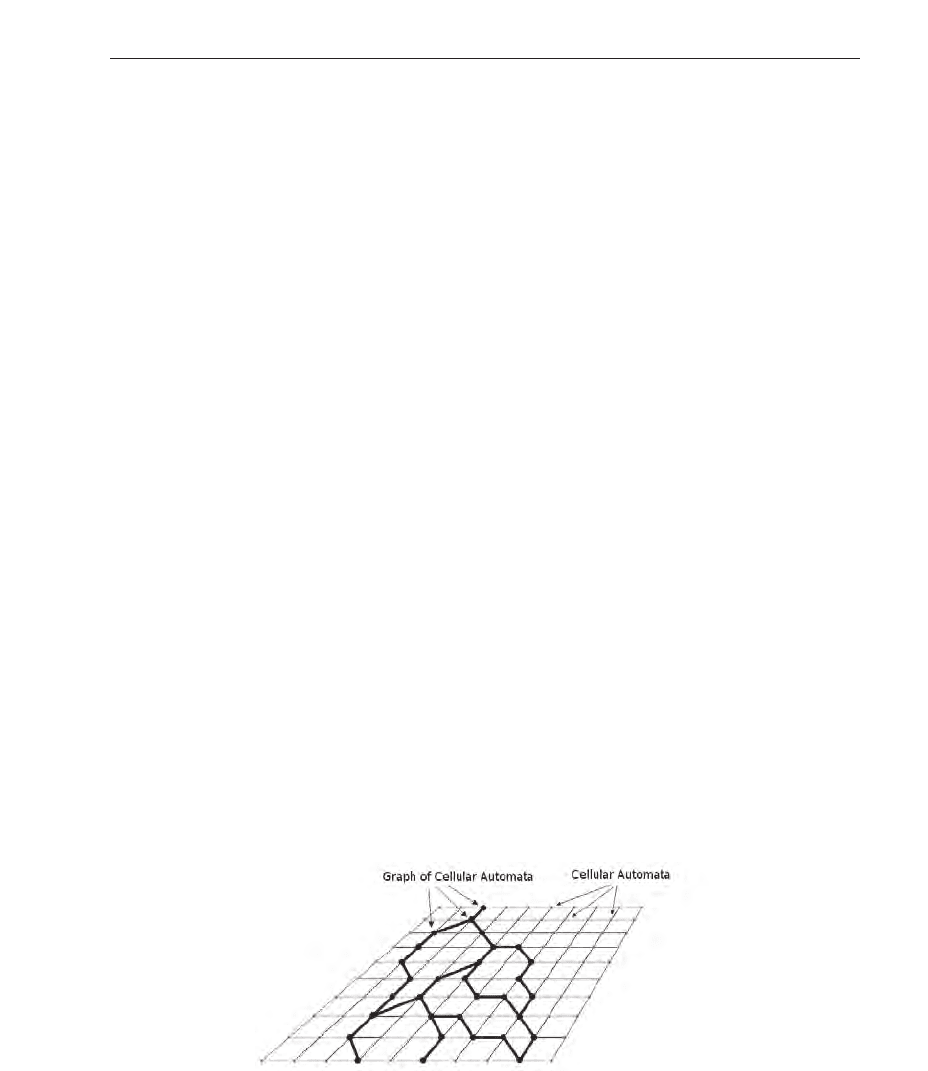
I conclude the chapter with discussion on extensions and modifications that make Cellular
Automata useful in modelling physical systems.
2. Network systems modelled with cellular automata
Cellular Automata fit best for modelling systems that are characterized by inner structural
homogeneity and regularity, for example crowd of pedestrians or fluids. When we look for
Cellular Automata that are able to capture complex systems with interacting parts that have a
different structure, we have to extended classic definition and combine it with other methods.
One of the phenomena that we observe in everyday life are transportation systems located
in consuming or producing environments. Transportation networks are transfer pathways
for various substances which are produced or absorbed by surrounding environments. These
substances can also diffuse through the environment. We can enumerate two examples of such
the systems that we meet in everyday life:
• Vascular systems — blood vessels transport nutrients and oxygen which penetrate into the
tissue and nourish it. Products of metabolism penetrate from tissue to blood vessels and
they are removed from the body. Tissue can influence the vascular network by producing
various substances called angiogenic factors that stimulate angiogenesis (process of
formation of blood vessels).
• River systems — rivers transport organic and mineral materials from upper, erosional
part of river system to lower part were the loads are deposited. In whole the basin, the
surrounding environment (shape of terrain) are modified by river (erosion and deposition).
Changes in terrains influence river systems by changing the routes of channels as well as
the shape of network.
Such the systems are characterized by coexistence two parts having completely different
structure. Environment has (in general) regular, uniform structure where substances are
distributed or collected in whole area or volume. Regular mesh with dense network of
connection between cells can accurately approximate these processes. In the networks,
processes are rather limited to the paths defined by their branches. Thus, we can easily
simplify their representation by using graph.
Graph of Cellular Automata is a hybrid modelling method employing Cellular Automata
theory and some elements of graph theory. Cellular Automata is a basis that is used to
construct graph. Some cells from mesh of automata are selected and they establish set of nodes
in graph. An additional relations of neighbourhood are established between these cells, what
constitute set of edges. Figure 1 illustrates this structure.
Fig. 1. Graph of Cellular Automata, from Topa & Dzwinel (2009)
261
Network Systems Modelled by Complex Cellular Automata Paradigm
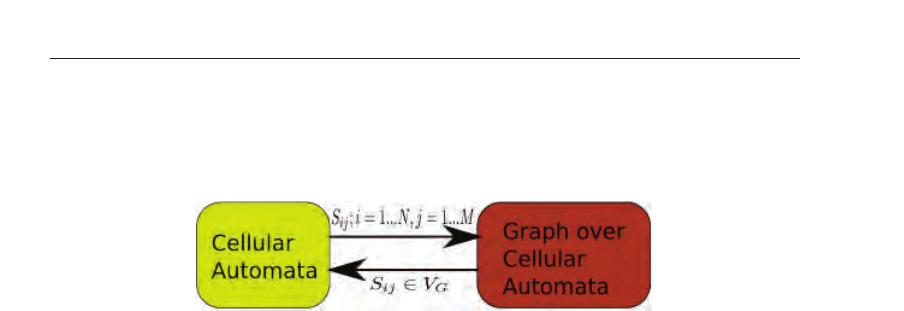
Regular mesh and graph are processed separately and often in different manner (e.g.
synchronously versus asynchronously). Cells that belong to the graph act as connections
between these two systems and provide interaction between them. State of these cells are
transfer way for results of environment simulation on regular mesh of Cellular Automata to
the graph structure representing network system (see Fig. 2).
Fig. 2. Interaction between Cellular Automata and Graph constructed over Cellular
Automata is transfered through the states of cells. States of all the cells in the mesh (S
ij
) can
influence evolution of network system encoded in graph. Network system influences
environment through the cells that belong to graph (S
ij
∈ V
G
)
The paradigm of Graph of Cellular Automata was applied for simulating two phenomena:
• Anastomosing river systems Topa & Dzwinel (2003); Topa et al. (2006); Topa & Paszkowski
(2001)
• Tumour Induced Angiogenesis Topa (2006; 2008); Topa & Dzwinel (2009)
2.1 Rivers and anastomosing river systems
Anastomosing rivers are interesting dynamic system created as a result of interaction between
constructive and destructive processes. Anastomosing systems are formed in middle part of
river system. Slope on these area is very small — approximately 10cm per 1km. Flow rate
is also very small, river do not erode terrain. Organic and non-organic materials carried by
river are mostly transported through this part of river and deposited later in lower reaches.
Waters rich of nutrients penetrate soil in surrounding banks. Fertile areas near river channels
are characterized by a significant increase in vegetation. Products of plant decay deposit on
this area as peat (approximately 1-1.5 mm/year Gradzinski et al. (2003)). Peat accumulation
lasting for thousands years may produce a peat bog with a depth of several meters.
The processes that occur on river channel banks are crucial for creation anastomosing
system. Figure 3 illustrates these processes. It presents cross-section of river channel. The
rate of peat accumulation depends on the distance from river channel. Water penetrates soil
nearby the channel and supplies nutrients. Nutrients are gathered by plants that vegetate
on the river banks. On the areas that are more distant from water, the vegetation are less
abundant than on the areas that directly neighbour to channel. Consequently, the rate of peat
deposition decreases with distance from channel. Deposition on river banks is accompanied
by deposition on river bottoms. As a result the whole river channel is raised (see in Fig 3). The
water level is raised above the average valley ground level. Sometimes channel can be also
partly blocked by clusters of floating plants, tree trunks etc. It is metastable state which can
be easily destroyed. High levels of water that usually occur during spring floods can cause
breaking river banks above obstacles. River can create bypass channel that evade narrowness
on primary channel. The shape of terrain in valley usually force new channel to join primary
channel somewhere downstream.
The routes of new channels run through local depression areas. Evolution of new channel
proceed in the same way as the parent channel. Old channels may also disappear gradually.
The system evolves to dynamic metastable state in which whole the area of the valley is
262
Cellular Automata - Simplicity Behind Complexity

Fig. 3. Crossection of anastomosing river channel
equally supplied by river systems. As a result the bottom of valley raises covered by thick
(several meters) layer of peat-bog.
Anastomosing rivers create very complex pattern of forking and joining channels. Fig. 4
presents part of real network of river Narew located in eastern Poland (Central Europe). It is
relatively small anastomosing river comparing to huge anastomosing systems created by river
Ob in Syberia (anastomising system can be observed from space) and Okawango in Africa.
2.2 Vascular system and tumour-induced angiogenesis
Angiogenesis is the process of formation of vascular network Carmeliet (2005).
Physiologically this process occurs during embryogenesis. In mature organisms it often
accompanies to cancer development and this pathological process is called tumour-induced
angiogenesis. Inhibition of tumour induced angiogenesis is one of the treatments applied in
oncology.
Tumour growth is a multi-stage and multi-scale process that starts with the loss of control of
cell proliferation Carmeliet (2005). Initially, tumour is in avascular state and draws nutrients
from surrounding vessels. At this stage cluster of tumour cells can reach size aproximately 1
-
3 mm. Tumour remains in steady state with balance between dying and proliferating cells.
Without blood vessels, tumours cannot grow beyond a critical size and invade other regions
of body. Tumour induced angiogenesis starts when the production of pro-angiogenic factors
overcomes other forces that kept the angiogenesis quiescent so far.
Oxygen and nutrients penetrate the tissue only in a certain distance from the vessel. Distant
cells, influenced by metabolic stresses, synthesise several angiogenic stimulators including
VEGF (Vascular Endothelial Growth Factor) and PDGF-BB (Platelet-derived growth factor),
Ang2 and NOS (Nitric Oxide Synthase) Carmeliet (2005); Steve et al. (2004). Stimulators
migrate towards the nearest blood vessels. When they reach vessel, the endothelial cells (ECs)
that lines the wall of this vessel are activated. They start to proliferate and migrate towards
the tumour cells attracted by VEGF and other stimulators. The wall of the parent blood vessel
becomes degraded and it opens to a new capillary. Migrating and proliferating ECs form a
hollow tube-like cavity (the lumen), which are stabilised later by smooth muscle cells and
perycites.
There are many differences between normal and tumour induce
d angiogenesis. Temporal and
spatial expression of angiogenic factors are not well coordinated, what follows to non-uniform
vascular development. As a result, new vessels form a highly chaotic and disorganised
network Tonini et al. (2003). Tumour vessels are deprived various protective mechanisms i.e.
perivascular cells that protect vessels from changes in oxygen or hormonal balance. Moreover
the lumen does not have proper construction. Their walls may be partially constructed from
cancer cells. They have also pathological form, e.g. they are thin and permeable, their diameter
263
Network Systems Modelled by Complex Cellular Automata Paradigm
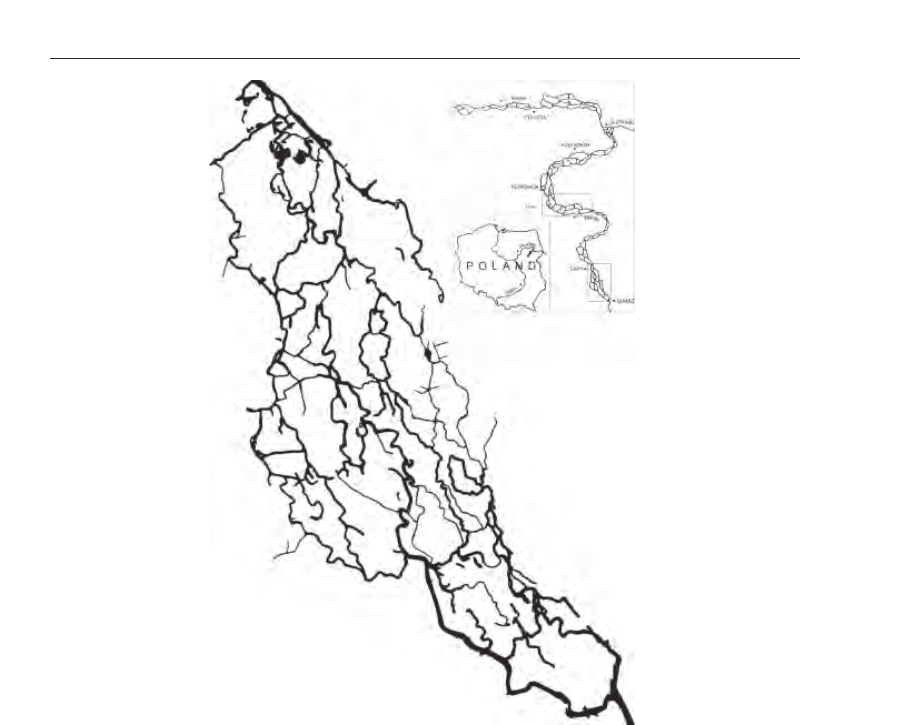
Fig. 4. Pattern of river channels in anastomosing part of Polish river Narew, from Topa et al.
(2006)
changes abruptly. Proliferating cancer cells can also crash the vessels. All it makes that newly
formed capillaries are still unable to supply starving tumour cells with oxygen and nutrients.
Inhibition of tumour-induced angiogenesis is one of the most promising strategy in
anti–cancer therapy Carmeliet (2005); Ferrara & Kerbel (2005). Tumour cells deprived of
nutrients and oxygen undergo necrosis. Moreover, the lack of vascular system prevents cancer
cells from invading to other tissues (there is no routes, which tumour cells can use to transfer
to other part of body). However, clinical tests show that none of the tested inhibitors succeed
in broad range types of cancers Carmeliet (2005). Monotherapies fail because angiogenesis
is controlled by very complex balance of stimulators and inhibitors. Therefore, further
investigations have to concentrate on studies including wider range of angiogenic factors.
3. The models
The Graph of Cellular Automata modelling tool was initially invented for modelling
anastomosing river systems Topa & Paszkowski (2001). Pure Cellular Automata model
appeared too computationally demanding and it could not reflect global evolution of the
264
Cellular Automata - Simplicity Behind Complexity
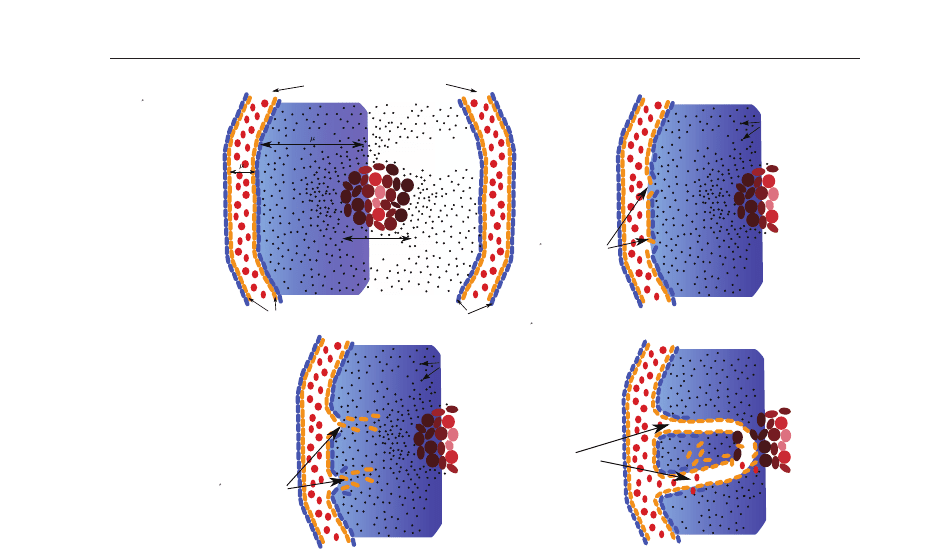
> 23
Fig. 5. Stages of tumour induced angiogenesis
system Topa et al. (2006). The model called MANGraCA (Model of Anastomosing Network
with Graph of Cellular Automata) is constructed in the following way:
Cellular Automata is applied to model peat bog in the river valley and the following
processes are reflected in this part of the model:
• nutrient distribution,
• growth of peat layer.
Graph of Cellular Automata is applied to model network of river channels. The following
processes are implemented in this module:
• flow in river channels,
• decreasing of channel throughputs caused by peat bog development and
sedimentation,
• branching, routing of new channels, anastomosing.
Cells that belong to the graph are the source of nutrients from where they are distributed
over the regular mesh of automata that represent peat bog.
In more formal way the model can be defined as follows:
CA
MANGraCA
= Z
2
, X
K
, G
CA
, S, δ
K
, δ
G
(1)
• Z
2
— a collection of cells ordered as a square or hexadecimal mesh of Z ×Z cells,
• X
K
— neighbourhood for the (i, j) cell in the regular mesh of automata (Moore
neighbourhood is used in the model),
• G
CA
— a planar, directed and acyclic graph defined as (V
G
, E
G
), where V
G
⊂ Z
2
and
E
G
⊂ Z
2
× Z
2
are finite sets of vertices and edges, respectively,
265
Network Systems Modelled by Complex Cellular Automata Paradigm
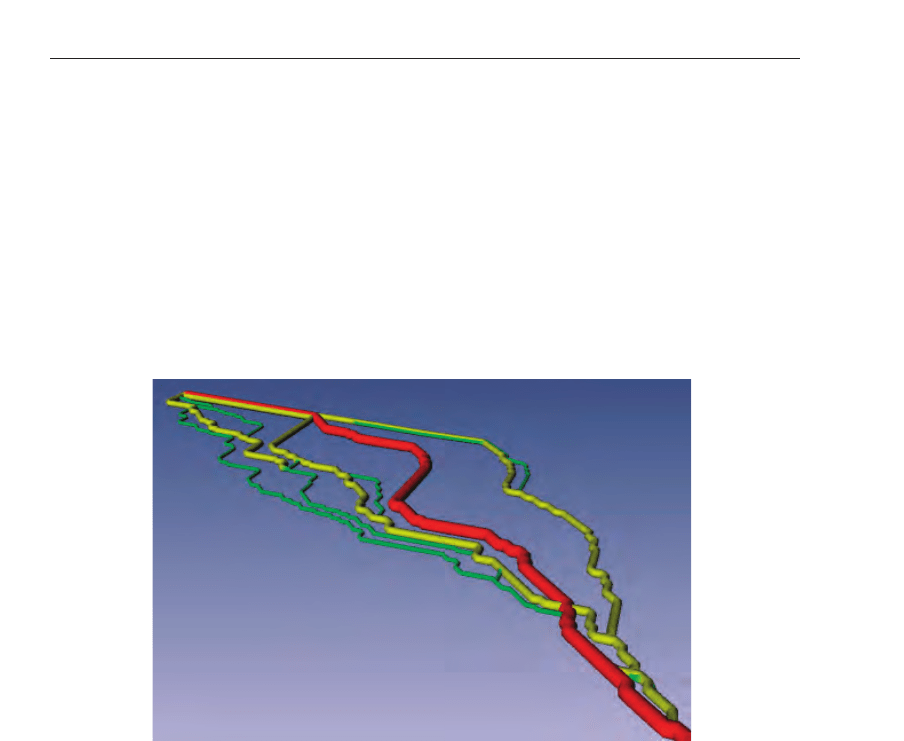
• S — is the set of state vectors corresponding to each cell: S = S
m
×S
g
:
1. states for cells in regular mesh S
m
=(g, n, p):
(a) g — initial altitude,
(b) p — thickness of peat layer,
(c) n — nutrients density,
2. states for graph cells S
g
=(f , r):
(a) f — flow rate,
(b) r — throughput;
• δ
K
: (g
t
, n
t
, p
t
) → (g
t+1
, n
t+1
, p
t+1
) — set of rules applied synchronously for each cell in
Z
2
.
• δ
G
: ( f
t
, r
t
) → ( f
t+1
, r
t+1
) — set of rules applied for each cell that belong to graph.
Fig. 6. Hierarchical structures of anastomosing pattern generated with model of
anastomosing river.
The simulation program consists of two modules:
1. Cellular Automata Module — it calculates and update cells in regular mesh of cellular
automata. It simultaneously apply defined rules of local interactions (δ
K
) to each cell in the
mesh and calculated new states.
• Nutrients density (n
ij
) is calculated as average density in neighbourhood. Cells that
belong to graph have maximum density.
• Thickness of peat layer (p
ij
) is increased proportionally to the nutrients density.
2. Graph of Cellular Automata Module — it updates states of the cells that belong to the
graph.
• Throughput r
ij
is decreased proportionally to thickness of peat bog layer (p
ij
)in
neighbourhood with random modifier.
• Flow rate f
ij
is updated asynchronously starting from “root” node of the network. The
flow in river channels was calculated by using simple algorithm: the amount of water
that enters the node is equal to amount that leaves node.
266
Cellular Automata - Simplicity Behind Complexity
